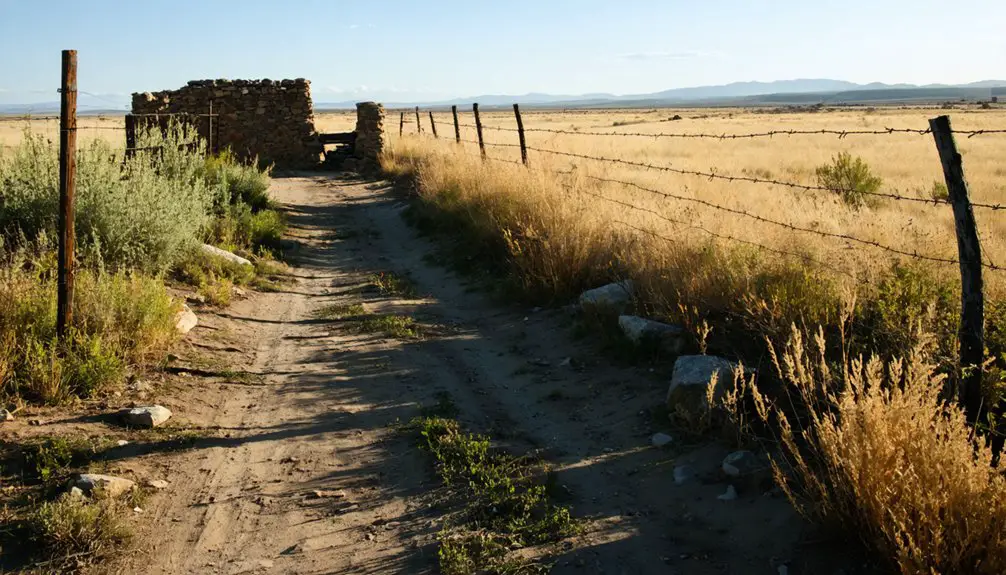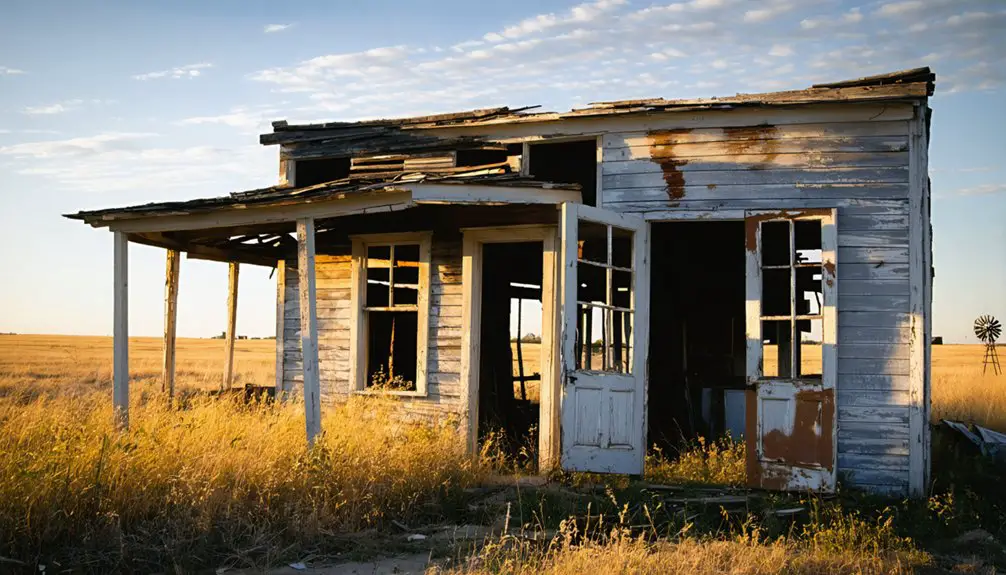You’ll find Diamond Springs, Kansas started as a vital Santa Fe Trail stop in 1825 when Ben Jones discovered its natural spring. The settlement thrived until pro-slavery forces destroyed it in 1863 during the Civil War. Though rebuilt nearby and later established as a railroad station in 1868, the town gradually declined. After its post office closed in 1930, it transformed into private ranch land. The site’s stone ruins and historic spring hold fascinating tales of frontier life.
Key Takeaways
- Diamond Springs was established in 1825 around a natural spring, serving as a vital stop along the Santa Fe Trail.
- The original settlement was destroyed by pro-slavery forces in 1863, leading to relocation three miles south.
- The town became a railroad station in 1868 but never exceeded 27 residents, ultimately failing to sustain its population.
- The post office closure in 1930 marked Diamond Springs’ final transformation into a ghost town.
- Today, stone ruins, a historic spring, and cemetery remain on private ranch land west of Council Grove.
Origins Along the Santa Fe Trail
When Old Ben Jones discovered a natural spring during the 1825 Santa Fe Trail survey, he couldn’t have known its lasting significance. His spring discovery quickly became an essential landmark, initially bearing his name before George Sibley renamed it “Diamond of the Plains” – inspired by a similar oasis in Arabia.
You’ll find the spring’s water significance reflected in every trail guide and traveler’s journal from the era. Its crystal-clear waters, abundant shade, and rich grasslands made it an ideal stopping point for weary travelers.
As the Santa Fe Trail developed into a major commercial route, Diamond Springs emerged as more than just a water source – it became a strategic gathering place where travelers formed larger groups for protection against tribal raids, marking the beginning of a settlement that would shape Kansas history. The establishment of a post office in 1859 helped cement the location’s importance as a permanent settlement. The spring now rises in a concrete cistern, preserving its historical role as a vital water source.
Rise and Fall of Early Settlement
You’ll find Diamond Springs’ earliest roots as an essential supply point along the Santa Fe Trail, where the Waldo Hall Company established a mail station in 1849 alongside two large stone buildings that served as hotel, restaurant, and mercantile operations.
The town’s strategic location made it an important rendezvous point for caravans seeking protection from raids, but pro-slavery forces destroyed the original settlement in 1863 during the Civil War. The site once supported hundreds of livestock in its expansive corrals.
While survivors rebuilt three miles south with help from Illinois settlers, the town never recaptured its former prominence and gradually faded, culminating in the closure of its post office in 1930. The spring that gave the town its name still flows today and is now directed into a concrete trough for livestock.
Early Santa Fe Trail
The Santa Fe Trail‘s emergence as an essential trade route in the 1820s brought Diamond Springs to prominence as a significant waypoint. You’ll find this oasis, discovered by hunter Ben Jones in 1825, located 13.5 miles west of Council Grove, Kansas.
Initially named Jones Spring, it earned the nickname “Diamond of the Plains” for its pristine, cold water that proved essential for trail commerce.
- Natural resources supported both livestock and travelers with abundant grass and shade trees
- Served as a strategic gathering point for forming larger caravans against Native American raids
- Positioned at a pivotal crossing near what would become the Santa Fe Railroad tracks
- Featured in every known 19th-century Santa Fe Trail guide as a key stop
This natural spring’s significance grew as international trade expanded following Mexico’s 1821 independence from Spain.
The spring was one of several notable camping stations that provided crucial rest stops for weary travelers along the 750-mile journey.
Town’s Gradual Abandonment
Despite its early prominence as a Santa Fe Trail station, Diamond Springs experienced a dramatic decline by the mid-1860s, leaving only ruins of three stone buildings, a dramshop, and a large corral as evidence of its past significance.
A devastating Confederate attack in 1863 contributed significantly to the town’s initial downfall.
When observer Samuel A. Kingman visited in 1865, he found the once-bustling station nearly deserted, with only sparse hay supplies remaining.
The decline reasons were complex and interconnected. The diminishing Santa Fe Trail traffic dealt the first blow to the community dynamics.
Natural disasters like tornadoes and floods may have further accelerated the town’s abandonment.
While a new railroad settlement briefly revived the area in 1868, establishing a post office and attracting 27 residents by 1910, this renaissance proved short-lived.
The community’s ultimate fate was sealed by the post office’s closure in 1930, mechanization of agriculture, and the draw of larger nearby towns.
Today, you’ll find only scattered homes, stone ruins, and a cemetery marking this former frontier hub.
Railroad Era Development
You’ll find Diamond Springs re-established itself in 1868 as a station along the Strong City & Superior Division of the Atchison, Topeka & Santa Fe Railroad, positioned at the crossing of the tracks west of Council Grove.
The railroad’s arrival attracted a small but steady stream of settlers, with the town reaching a population of 27 by 1910. The Bummies Store, established in 1947 next to the Santa Fe depot, became the heart of community life. The town’s eventual decline was marked by the closure of its post office in 1930.
The station’s primary function was as a minor shipping point for local agricultural products, serving the surrounding farming community with essential rail transport services.
Early Railroad Station Construction
When railroad development reached Diamond Springs in 1868, construction began on a station complex that would serve as an essential shipping point along the Atchison, Topeka & Santa Fe Railroad’s Strong City & Superior Division.
The station architecture featured sturdy two-story stone buildings, incorporating shipping facilities designed to handle agricultural freight and livestock transport. You’ll find the station was strategically positioned near the historic Diamond Springs spring, with stone corrals and essential infrastructure to support regional commerce. The site was later sold to Charley Owens who attempted to maintain operations until the Cheyenne raids.
- Low stone buildings housed multiple functional rooms for operations
- Log stores provided essential supply storage and distribution
- Large stone corrals facilitated livestock handling and transport
- Post office integration enhanced the station’s community role as a communications hub
The construction reflected the frontier’s practical needs, combining durability with functionality to serve the emerging railroad economy.
Population Growth Along Tracks
The railroad station’s construction sparked modest settlement patterns in Diamond Springs, though the town never achieved the explosive growth seen in other railway communities. By 1910, you’d have found only 27 residents, mainly consisting of scattered farm families and railroad workers who’d settled along the tracks.
Swedish families were among the early settlers, purchasing quarter sections near the Atchison, Topeka & Santa Fe line. Agricultural influence remained the primary driver of the area’s limited development, with the station serving as a minor shipping point for local farm goods.
The settlement patterns remained dispersed rather than concentrated, and you wouldn’t have seen the dense population typical of more successful railroad towns. This sparse development continued until 1930, when the post office’s closure signaled the community’s decline into a ghost town.
Transformation Into Private Ranch Land
Following the closure of its post office in 1930, Diamond Springs transformed from a small railroad settlement into privately-owned ranch land. The land use shifted dramatically as agricultural efficiency improvements made large-scale ranching more viable than maintaining a small town.
The death of Diamond Springs’ post office marked its transformation from bustling railroad stop to vast ranchland, swept away by agricultural progress.
You’ll find the former townsite now incorporated into Diamond Spring Ranch, where the historic spring has been piped into a concrete stock tank for cattle.
- Stone ruins of original buildings remain scattered across the private property
- The historic cemetery features a monument marking the site’s significance
- Natural spring water continues to serve ranch operations today
- Private ownership restricts public access to the former townsite
The ranch conversion preserved some historical elements while adapting the land for modern agricultural use, reflecting broader economic changes that affected many Kansas ghost towns during the mid-20th century.
Current Site Features and Access

Modern visitors to Diamond Springs will find a landscape dominated by ranch features rather than the bustling settlement that once existed.
You’ll see stone ruins scattered across the private property, including foundations of the former hotel, restaurant, saloon, and store. The historic spring now rises in a concrete cistern, with water piped to a nearby stock tank.
Site accessibility is limited due to private property restrictions. If you’re interested in viewing the area, you can reach it by taking U.S. Highway 56 west from Council Grove for 13.5 miles, then heading south on Kansas Highway 149 for half a mile to the railroad crossing.
While exploring, you’ll notice the old cemetery, stone corral remnants, and a historical marker commemorating Diamond Springs’ significance on the Santa Fe Trail.
Historical Legacy in Chase County
Once known as the “Diamond of the Plains,” Diamond Springs emerged as an important waypoint on the Santa Fe Trail when surveyors first documented it in 1825.
You’ll find its historical significance deeply woven into Chase County’s cultural heritage, from its early days as an essential water stop to its later role as a railroad town.
- The spring’s reliable water source made it indispensable for Santa Fe traders and settlers
- A monument in Diamond Springs Cemetery preserves the town’s historical importance
- The site’s stone ruins and preserved spring serve as tangible links to Kansas’ pioneer past
- Its story mirrors other Chase County ghost towns affected by changing transportation patterns
Despite its eventual decline, Diamond Springs continues to represent a significant chapter in Kansas’ westward expansion narrative, marked by shifting populations and evolving transportation networks.
Frequently Asked Questions
Were There Any Notable Crimes or Shootouts in Diamond Springs?
You won’t find notable incidents of shootouts or major crimes there. While pro-slavery forces destroyed the town in 1863, historical records show no specific law enforcement cases beyond the Civil War destruction.
What Happened to the Original Residents After the Town Declined?
You’d find most original residents moved to larger towns during post decline migration, seeking better economic opportunities. Some stayed in Morris County as farmers, while others spread across Kansas and neighboring states.
Did Native American Tribes Have Connections to Diamond Springs?
You’ll find strong tribal connections at these springs, where Comanche, Kiowa, and Cheyenne Native American tribes frequently visited. They’d use the water source before settlers arrived and during trail years.
What Was the Average Cost of Property During Diamond Springs’ Peak?
While precise data isn’t available, you’d find 19th-century real estate trends show rural Kansas lots sold for under $100, with surrounding farmland costing $20-30 per acre near railroad access points.
Were There Any Schools or Churches Established in Diamond Springs?
You won’t find records of any established schools or churches in historical documents. The small population and commercial focus meant the community likely relied on nearby towns for school history and church community needs.
References
- https://www.legendsofamerica.com/diamond-springs-kansas/
- https://visitemporia.com/place/diamond-springs-cemetary/
- https://www.ghosttowns.com/states/ks/diamondsprings.html
- https://thewanderingpigeon.com/2015/10/03/day-of-kansas-ghost-towns/
- https://legendsofkansas.com/kansas-ghost-town-list/
- https://en.wikipedia.org/wiki/Diamond_Spring_(Wilsey
- https://www.legendsofamerica.com/ks-santafetrailmrco/
- https://www.nps.gov/safe/learn/historyculture/index.htm
- https://lostkansas.ccrsdigitalprojects.com/directory/santa-fe-trail
- https://fromthebarberschair.wordpress.com/tag/diamond-springs/



